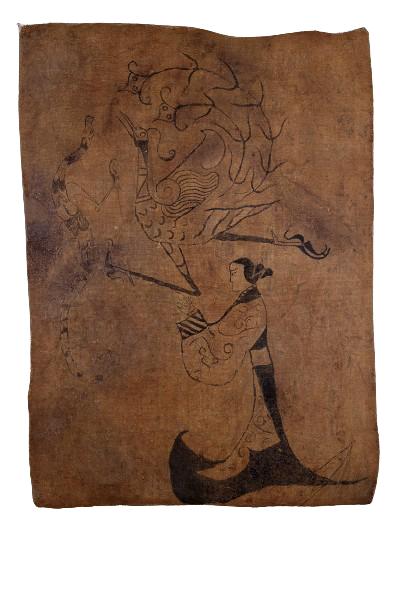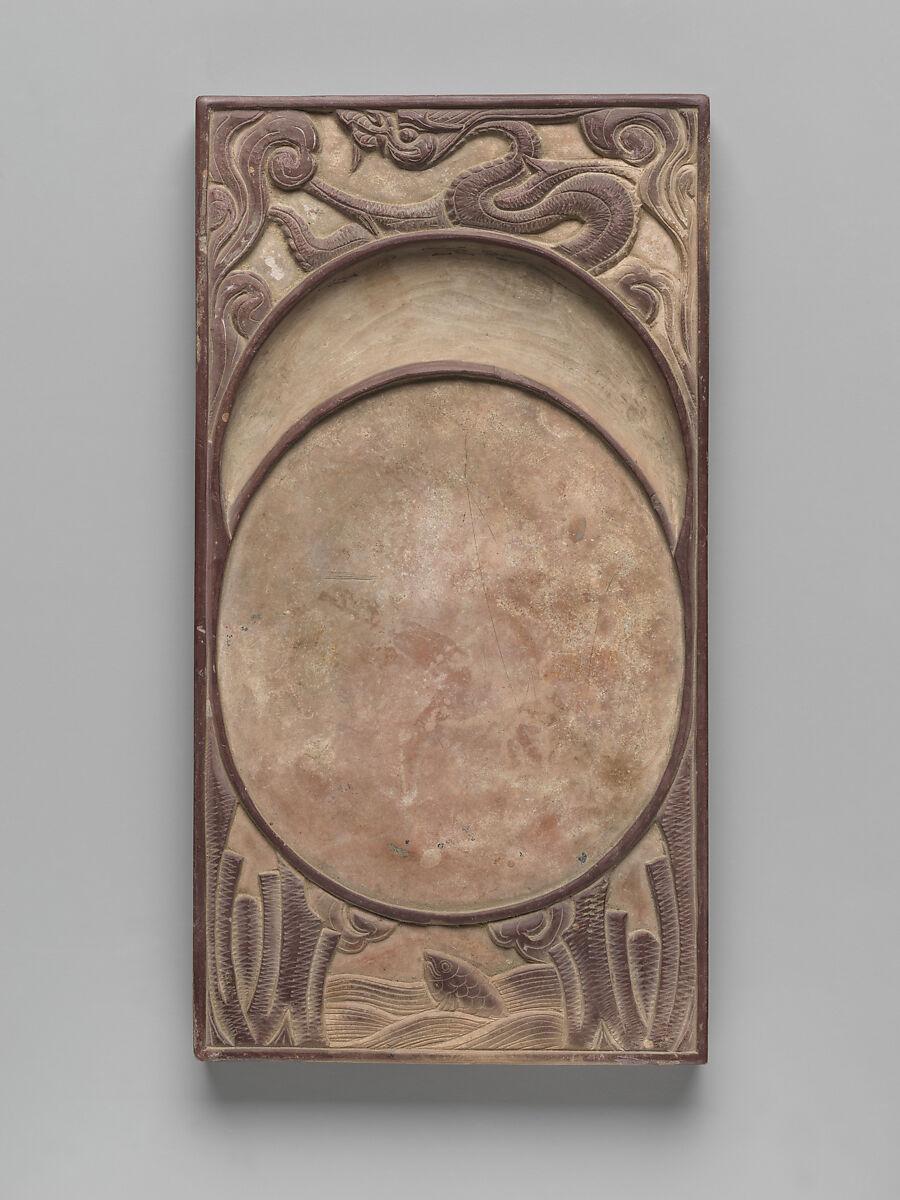Editor's Note: In China, the year 2024 is heralded as the Year of the Dragon, or "loong," as it is known in Chinese. This mythological creature is a symbol of good luck and appears on many cultural artifacts passed down through Chinese history. We've selected three loong-themed cultural relics and three lucky loong idioms to illuminate the differences between Chinese loongs and their Western counterparts. Here's to a New Year filled with joy and prosperity, enriched by the mystical charm of the loong! The jade loong from the Neolithic Hongshan culture is displayed at the National Museum of China, Beijing. [Photo/National Museum of China] The jade loong, carved from dark green Xiuyan jade, boasts a smooth and sleek body. Its head features a long snout and slender eyes, with a mane that seems to float, and its body curls like a hook. Vivid in shape and exquisitely carved, it enjoys the reputation of being "China's First Loong." Many relics from the Neolithic Age showcase loong-like remains, whether they be Bang Su (sculptures inlaid with clamshells), colored paintings, or sculptures. Researchers have proposed various hypotheses regarding the inspiration for the loong, such as snakes, crocodiles, lizards, fish, salamanders, horses, cows, pigs, deer, bears, tigers, silkworms, grubs, pine trees, clouds, and lightning, among others. Oracle bone inscriptions from the Shang dynasty and the jade loong depict the loong as a giant, horned creature with a large mouth and a curved body. Similar jade relics have also been found in Hanshan county, Anhui Province, and at the "Xiao Jia Wu Ji" (Ridge of Xiao's Family) in Tianmen city, Hubei Province, which may represent the earliest depictions of the loong. Opinions on the origin of the loong vary, with suggestions including lizards and crocodiles. It is suggested that the loong's head may derive from that of a horse, cow, or pig. The jade loong is among the earliest depictions of a loong discovered in China. The head features a long snout and a protruding nose with an upturned edge. The end is truncated, displaying two side-by-side nostrils, which gives it characteristics resembling a pig's head. Crafted from black and green jade, the jade loong holds significant artistic value. 龙年大吉(Long Nian Da Ji) Unlike Western dragons, which are often depicted as aggressive, fire-breathing, flying lizards, Chinese loongs traditionally symbolize potent and auspicious powers, particularly control over water. In Chinese mythology, the loong is credited with bringing rain and ensuring a bountiful harvest. The unique appearance of the Chinese loong, with fish scales, a serpentine body, deer horns, and eagle claws, distinguishes it from its Western counterparts. For thousands of years, the Chinese have venerated the loong, believing that they can bring harmony and prosperity. According to Chinese mythology, the legendary ruler, the Yan Emperor (炎帝), was conceived through his mother's telepathy with a mythological loong. As the Chinese regard the Yellow Emperor and the Yan Emperor as their forefathers (炎黄子孙), they sometimes refer to themselves as "descendants of the loong (龙的传人)." At the Fuxin Chahai historical site (阜新查海遗址) in Liaoning Province, a stone sculpture of a loong was discovered in 1994. Measuring 19.70 meters in length, with a width of 2 meters at the head and about 1 meter from the torso to the tail, the sculpture's age has been established by radiocarbon dating to be between 7,600 and 8,000 years old. The idiom 龙年大吉 means "good luck in the year of the loong." We wish our readers a happy and auspicious Chinese New Year! Silk painting featuring a female figure, loong, and fenghuang (Chinese phoenix) from the Warring States Period (475-221 B.C.), housed in Hunan Museum, Changsha, central China's Hunan Province. [Photo/Hunan Museum] This silk painting, unearthed in 1949 from the Tomb of Chu State in Changsha, Hunan Province, embodies simplicity and elegance. The painting is divided into three sections. At the top, a fenghuang and a loong are depicted. The fenghuang spreads its wings, preparing to soar, while the loong, adorned with two horns, flies across the sky. In the center, a noblewoman with a hair bun, a slender waist, wide sleeves, and a long dress is depicted. Presumably representing the deceased in the tomb, she is shown with her hands folded. In the bottom part, there is a crescent moon, believed to represent the spiritual canoe that transports the deceased's soul to heaven. Ancient Chinese artists utilized traditional ink and brush techniques to produce smooth and lifelike lines. The expressive power of their art is immense. This silk painting is among China's earliest and best-preserved portraits. 龙凤呈祥 (Long Feng Cheng Xiang) The Chinese fenghuang is distinct from the Western phoenix, which is often depicted as an immortal bird. In Chinese culture, the male is referred to as feng, and the female is referred to as huang. However, this gender differentiation is sometimes overlooked, combining them into a single feminine entity so the bird can be paired with the loong, typically considered male. In ancient China, the emperor was symbolized by the loong and the empress by the fenghuang. In Chinese folklore, the appearance of the fenghuang in the sky heralds the arrival of a peaceful and prosperous era. The ancient Chinese idiom "龙凤呈祥" translates literally to "Prosperity appears when the loong meets the fenghuang." As such, the loong and fenghuang frequently feature in major festivities in China, such as the Spring Festival, also known as Chinese New Year. May the Chinese loong and fenghuang bring us all good fortune! Inkstone depicting a loong and carp, 14th century, at the Metropolitan Museum of Art, New York City, U.S. [Photo/Metropolitan Museum of Art] This distinctive inkstone is crafted from chengni, or "filtered clay," a type of stoneware made from extremely fine silted clay that has been subjected to a labor-intensive process of filtering, kneading, molding, firing, and carving. Chengni inkstones gained popularity during the Song Dynasty (960–1279), but the vigorous carving style of this piece suggests it dates to the 14th century. The decoration on the inkstone draws on the myth that if a carp succeeds in swimming upstream through the Loong Gate on the Yellow River, it will transform into a loong. This tale serves as a metaphor for success in the civil service exam, with the inkstone and inkwell symbolizing the hard work and diligence that could spell the difference between failure and success. 鲤跃龙门(Li Yue Long Men) In Chinese mythology, it's said that many carp swim upstream against the strong current of a magical river each year, yet only a few manage to leap over the waterfall at its end. If a carp successfully jumps over the waterfall that flows from the legendary mountain known as the Loong Gate (龙门), it transforms into a powerful loong. This myth is so ingrained in Chinese culture that there's a popular saying: "A student facing his exams is like a carp trying to leap over the Loong Gate." This transformation is encapsulated in the proverbial idiom "Liyu (Carp) jumps over the Loong Gate" (鲤跃龙门), which symbolizes a dramatic rise in one's social status, akin to entering upper society or gaining favor with royalty or a noble family, often through marriage, but especially through success in the imperial examinations. The idiom serves as an encouragement for students and children to achieve success through dedication, hard work, and perseverance.


Exploring the Chinese loong through culture and art
Editor:谭婕倪
Source:en.people
Updated:2024-02-08 17:45:57
Source:en.people
Updated:2024-02-08 17:45:57
Special
Contact
Welcome to English Channel! Any suggestion, welcome.Tel:0731-82965627
lisl@rednet.cn
zhouqian@rednet.cn











